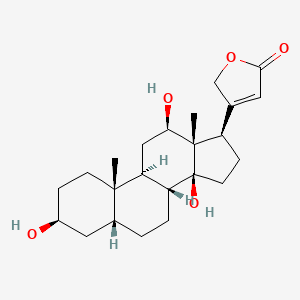| MeSH term | MeSH ID | Detail |
|---|---|---|
| Muscular Dystrophies | D009136 | 10 associated lipids |
| Astrocytoma | D001254 | 15 associated lipids |
Digoxigenin
Digoxigenin is a lipid of Sterol Lipids (ST) class. Digoxigenin is associated with abnormalities such as Renal tubular disorder, Albinism, vaginalis, Exanthema and Ischemia. The involved functions are known as Energy Absorption, Saturated, Transcription, Genetic, Amplification and Signal. Digoxigenin often locates in Tissue, Paraffin, Tissue membrane, Membrane, Blood and Body tissue. The associated genes with Digoxigenin are Mutant Proteins, Genome, Homologous Gene, Alleles and Immunoglobulin region. The related lipids are Steroids, Cardenolides and bufadienolide.
Cross Reference
Introduction
To understand associated biological information of Digoxigenin, we collected biological information of abnormalities, associated pathways, cellular/molecular locations, biological functions, related genes/proteins, lipids and common seen animal/experimental models with organized paragraphs from literatures.
What diseases are associated with Digoxigenin?
Digoxigenin is suspected in Renal tubular disorder, Albinism, vaginalis, Exanthema, Ischemia and other diseases in descending order of the highest number of associated sentences.
Related references are mostly published in these journals:
| Disease | Cross reference | Weighted score | Related literature |
|---|
Possible diseases from mapped MeSH terms on references
We collected disease MeSH terms mapped to the references associated with Digoxigenin
PubChem Associated disorders and diseases
What pathways are associated with Digoxigenin
There are no associated biomedical information in the current reference collection.
PubChem Biomolecular Interactions and Pathways
Link to PubChem Biomolecular Interactions and PathwaysWhat cellular locations are associated with Digoxigenin?
Visualization in cellular structure
Associated locations are in red color. Not associated locations are in black.
Related references are published most in these journals:
| Location | Cross reference | Weighted score | Related literatures |
|---|
What functions are associated with Digoxigenin?
Related references are published most in these journals:
| Function | Cross reference | Weighted score | Related literatures |
|---|
What lipids are associated with Digoxigenin?
Related references are published most in these journals:
| Lipid concept | Cross reference | Weighted score | Related literatures |
|---|
What genes are associated with Digoxigenin?
Related references are published most in these journals:
| Gene | Cross reference | Weighted score | Related literatures |
|---|
What common seen animal models are associated with Digoxigenin?
There are no associated biomedical information in the current reference collection.
NCBI Entrez Crosslinks
All references with Digoxigenin
Download all related citations| Authors | Title | Published | Journal | PubMed Link |
|---|---|---|---|---|
| Patel Y et al. | Clinicopathological Analysis of miRNA Expression in Breast Cancer Tissues by Using miRNA In Situ Hybridization. | 2016 | J Vis Exp | pmid:27341462 |
| Lai TP et al. | Generation of digoxigenin-incorporated probes to enhance DNA detection sensitivity. | 2016 | BioTechniques | pmid:27286808 |
| Sirenko SG et al. | Electrochemical Na+ and Ca2+ gradients drive coupled-clock regulation of automaticity of isolated rabbit sinoatrial nodal pacemaker cells. | 2016 | Am. J. Physiol. Heart Circ. Physiol. | pmid:27208164 |
| Kulkarni YM et al. | Autophagy-Induced Apoptosis in Lung Cancer Cells by a Novel Digitoxin Analog. | 2016 | J. Cell. Physiol. | pmid:26264876 |
| Okina Y et al. | Cardenolide aglycones inhibit tumor necrosis factor α-induced expression of intercellular adhesion molecule-1 at the translation step by blocking Naâº/Kâº-ATPase. | 2015 | Biol. Pharm. Bull. | pmid:25744456 |
| Glei M and Schlörmann W | Analysis of DNA damage and repair by comet fluorescence in situ hybridization (Comet-FISH). | 2014 | Methods Mol. Biol. | pmid:24162978 |
| Huovinen T et al. | The selection performance of an antibody library displayed on filamentous phage coat proteins p9, p3 and truncated p3. | 2014 | BMC Res Notes | pmid:25238965 |
| Staack RF et al. | Free analyte QC concept: a novel approach to prove correct quantification of free therapeutic protein drug/biomarker concentrations. | 2014 | Bioanalysis | pmid:24279646 |
| Takahata T et al. | Identification of ocular dominance domains in New World owl monkeys by immediate-early gene expression. | 2014 | Proc. Natl. Acad. Sci. U.S.A. | pmid:24591618 |
| Wu W et al. | Simple and nonradioactive detection of microRNAs using digoxigenin (DIG)-labeled probes with high sensitivity. | 2014 | RNA | pmid:24572812 |
